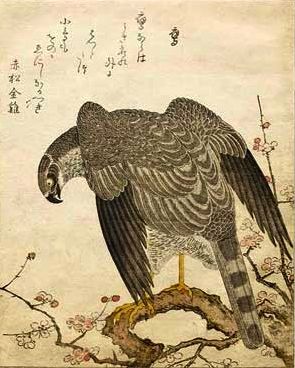A Bronze Sculpture of a Hawk on a Naturalistically Carved Wooden Base
By Masatsune Chu, Meiji Period, circa 1890
With applied plaque Masatsune
11 ½ in (29.2 cm) high
cf. Joe Earle, Splendours of Imperial Japan: Arts of the Meiji Period from the Khalili Collection, 2002, p. 369, no.260 – for a similar model by the same artist
11 ½ in (29.2 cm) high
cf. Joe Earle, Splendours of Imperial Japan: Arts of the Meiji Period from the Khalili Collection, 2002, p. 369, no.260 – for a similar model by the same artist
Following the decline of Japan's military government in 1868, the Emperor Meiji was restored to power. Japanese artisans, particularly metalworkers, lost their traditional samurai patrons and were obliged to find new markets for their skills. Emerging from its feudal past, Japan developed as a modern industrialised and economic power. It employed western technicians and advisors to work with Japanese artisans in developing new and improved methods of production.
At the great international exhibitions that were in vogue in the 19th century, Japan displayed its traditional arts and crafts, as well as other forms of manufacture. This bronze hawk represents Japan's traditional metalworking techniques such as bronze-casting, patination, decorative inlay and chasing. These techniques had previously been used to great effect on arms and armour for the samurai, but here they have been applied to purely decorative objects.
Masatsune, an imperial artist, was noted for his skill in bronze craftsmanship. Other works are held in the collection of the Boston Museum of Fine Arts.
At the great international exhibitions that were in vogue in the 19th century, Japan displayed its traditional arts and crafts, as well as other forms of manufacture. This bronze hawk represents Japan's traditional metalworking techniques such as bronze-casting, patination, decorative inlay and chasing. These techniques had previously been used to great effect on arms and armour for the samurai, but here they have been applied to purely decorative objects.
Masatsune, an imperial artist, was noted for his skill in bronze craftsmanship. Other works are held in the collection of the Boston Museum of Fine Arts.



















